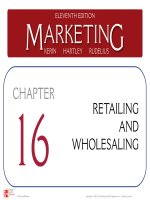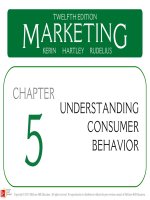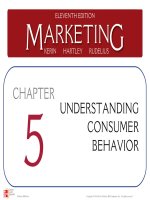Lecture Marketing: The core (5/e): Chapter 13 – Kerin, Hartley, Rudelius
Bạn đang xem bản rút gọn của tài liệu. Xem và tải ngay bản đầy đủ của tài liệu tại đây (2.31 MB, 34 trang )
McGrawHill/Irwin Copyright © 2013 by The McGrawHill Companies, Inc. All rights reserved.
LEARNING OBJECTIVES (LO)
AFTER READING CHAPTER 13, YOU SHOULD BE ABLE TO:
LO1
Identify retailers in terms of the
utilities they provide.
LO2
Explain the alternative ways to
classify retail outlets.
LO3
Describe the many methods of
nonstore retailing.
132
LEARNING OBJECTIVES (LO)
AFTER READING CHAPTER 13, YOU SHOULD BE ABLE TO:
LO4
Specify the retailing mix actions used
to implement a retailing strategy.
LO5
Explain changes in retailing with the
wheel of retailing and the retail life
cycle concepts.
LO6
Describe the types of firms that
perform wholesaling activities and
their functions.
133
RETAILERS LOVE IT
WHEN THE MAYOR VISITS!
134
THE VALUE OF RETAILING
LO1
Retailing
Consumer Utilities Offered by Retailing
CarMax
Video
• Place
• Form
• Possession
• Time
The Global Economic
Impact of Retailing
135
FIGURE 13-1 Which retailer best provides
which utilities?
136
LO2
CLASSIFYING RETAIL OUTLETS
Form of Ownership
Level of Service
Merchandise Line
137
LO2
MAKING RESPONSIBLE DECISIONS
GREEN ISN’T JUST A COLOR TO RETAILERS.
IT’S A VALUE!
138
LO2
CLASSIFYING RETAIL OUTLETS
FORM OF OWNERSHIP
Independent Retailer
Corporate Chain
Contractual Systems
• Wholesaler-Sponsored Voluntary Chains
• Retailer-Sponsored Cooperatives
139
LO2
CLASSIFYING RETAIL OUTLETS
FORM OF OWNERSHIP
Contractual Systems
• Franchising
Business-Format
Franchises
Product-Distribution
Franchises
1310
LO2
CLASSIFYING RETAIL OUTLETS
LEVEL OF SERVICE
Self-Service
Limited Service
Full-Service
1311
FIGURE 13-2 Stores vary in terms of the
breadth and depth of their merchandise
lines
1312
LO2
CLASSIFYING RETAIL OUTLETS
TYPE OF MERCHANDISE LINE
Depth of Product Line
• Specialty Outlets
• Category Killers
1313
LO2
CLASSIFYING RETAIL OUTLETS
TYPE OF MERCHANDISE LINE
Breadth of Product Line
• General Merchandise Stores
• Scrambled Merchandising
Hypermarket
Supercenter
Intertype Competition
1314
FIGURE 13-A For Lands’ End, intertype
competition means that there is competition
between various dissimilar retail outlets
1315
FIGURE 13-B Many retailing activities do
not involve a store
1316
LO3
NONSTORE RETAILING
Automatic Vending
Direct Mail and Catalogs
1317
NONSTORE RETAILING
LO3
Television Home
Shopping
Online Retailing
1318
NONSTORE RETAILING
LO3
Telemarketing
• Do-Not-Call Registry
Direct Selling
1319
FIGURE 13-3 Elements of a retailing
strategy
1320
RETAILING STRATEGY
LO4
RETAILING MIX
Retailing Mix
Retail Pricing
• Original Markup
• Maintained Markup
• Gross Margin
Markdown
1321
LO4
RETAILING STRATEGY
RETAILING MIX
Everyday Low Pricing (EDLP)
Everyday Fair Pricing
Benchmark or Signpost Items
1322
LO4
RETAILING STRATEGY
RETAILING MIX
Off-Price Retailing
• Warehouse Club
• Outlet Store
• Single/Extreme Value Store
1323
RETAILING STRATEGY
LO4
RETAILING MIX
Store Location
• Central Business District
• Regional Shopping Centers
Anchor Stores
• Community Shopping Center
• Strip Mall
• Power Center
1324
RETAILING STRATEGY
LO4
RETAILING MIX
Retail Communication
• Image
• Shopper Marketing
Merchandise
• Category Management
• Marketing Metrics
Sales per Sq. Ft.
Same Store Sales
1325









